Individual Written Portfolio on Information System and Big Data Analysis
VerifiedAdded on 2023/06/10
|10
|2966
|249
AI Summary
This report evaluates theories, methods, and techniques related to the design and development of information systems and big data analysis. It also discusses the impacts of IT on globalization, digital infrastructure, and risks associated with information systems outsourcing.
Contribute Materials
Your contribution can guide someone’s learning journey. Share your
documents today.
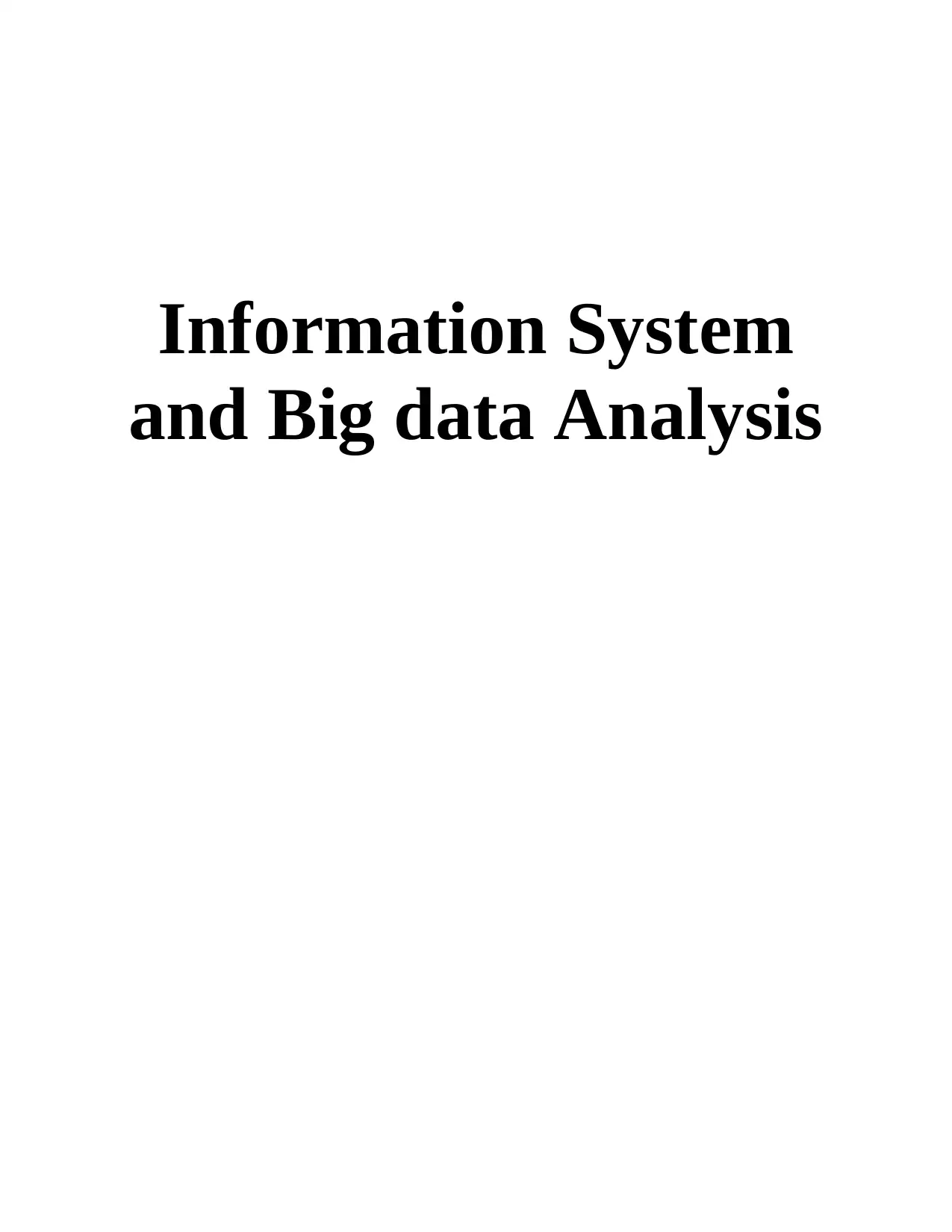
Information System
and Big data Analysis
and Big data Analysis
Secure Best Marks with AI Grader
Need help grading? Try our AI Grader for instant feedback on your assignments.
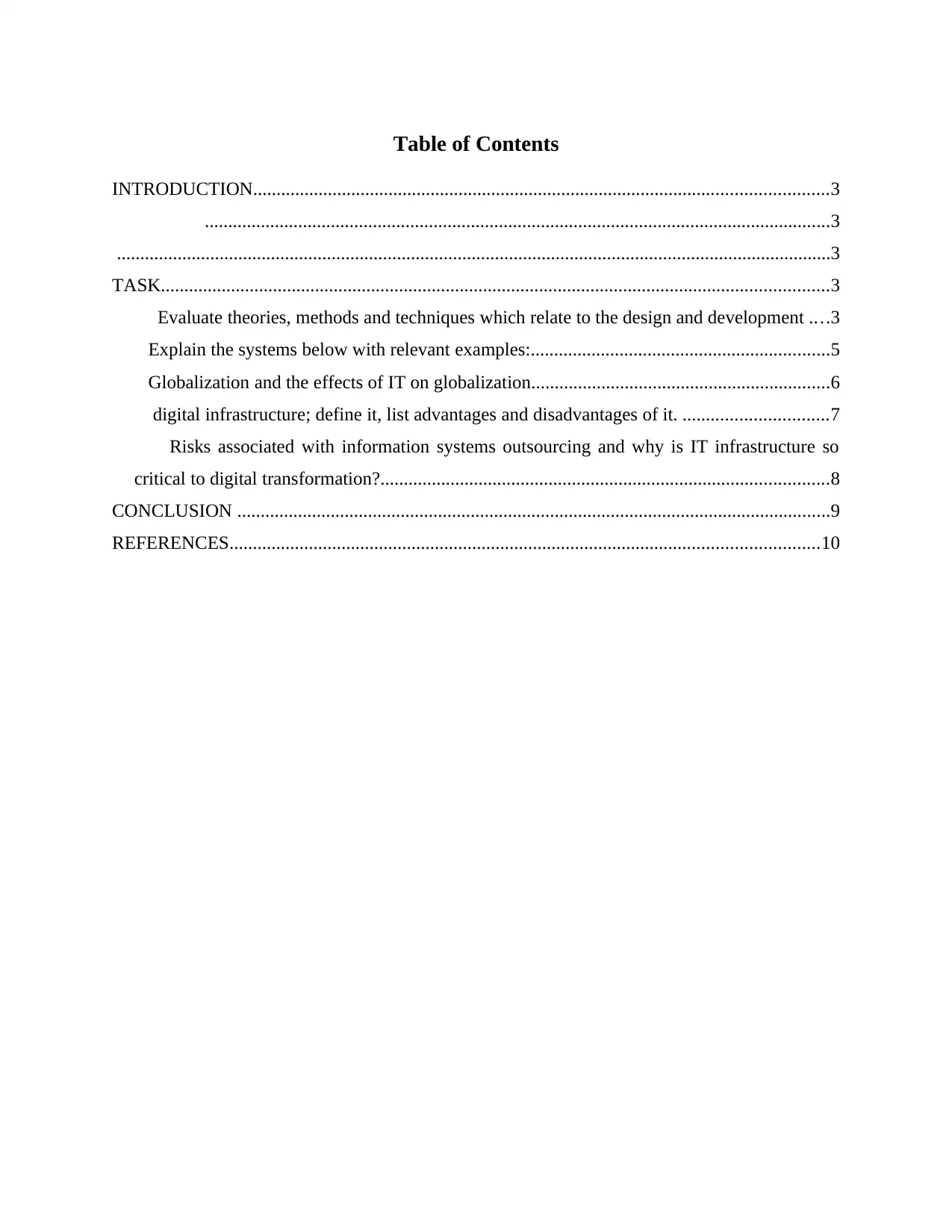
Table of Contents
INTRODUCTION...........................................................................................................................3
......................................................................................................................................3
.........................................................................................................................................................3
TASK...............................................................................................................................................3
Evaluate theories, methods and techniques which relate to the design and development ....3
Explain the systems below with relevant examples:................................................................5
Globalization and the effects of IT on globalization................................................................6
digital infrastructure; define it, list advantages and disadvantages of it. ...............................7
Risks associated with information systems outsourcing and why is IT infrastructure so
critical to digital transformation?................................................................................................8
CONCLUSION ...............................................................................................................................9
REFERENCES..............................................................................................................................10
INTRODUCTION...........................................................................................................................3
......................................................................................................................................3
.........................................................................................................................................................3
TASK...............................................................................................................................................3
Evaluate theories, methods and techniques which relate to the design and development ....3
Explain the systems below with relevant examples:................................................................5
Globalization and the effects of IT on globalization................................................................6
digital infrastructure; define it, list advantages and disadvantages of it. ...............................7
Risks associated with information systems outsourcing and why is IT infrastructure so
critical to digital transformation?................................................................................................8
CONCLUSION ...............................................................................................................................9
REFERENCES..............................................................................................................................10
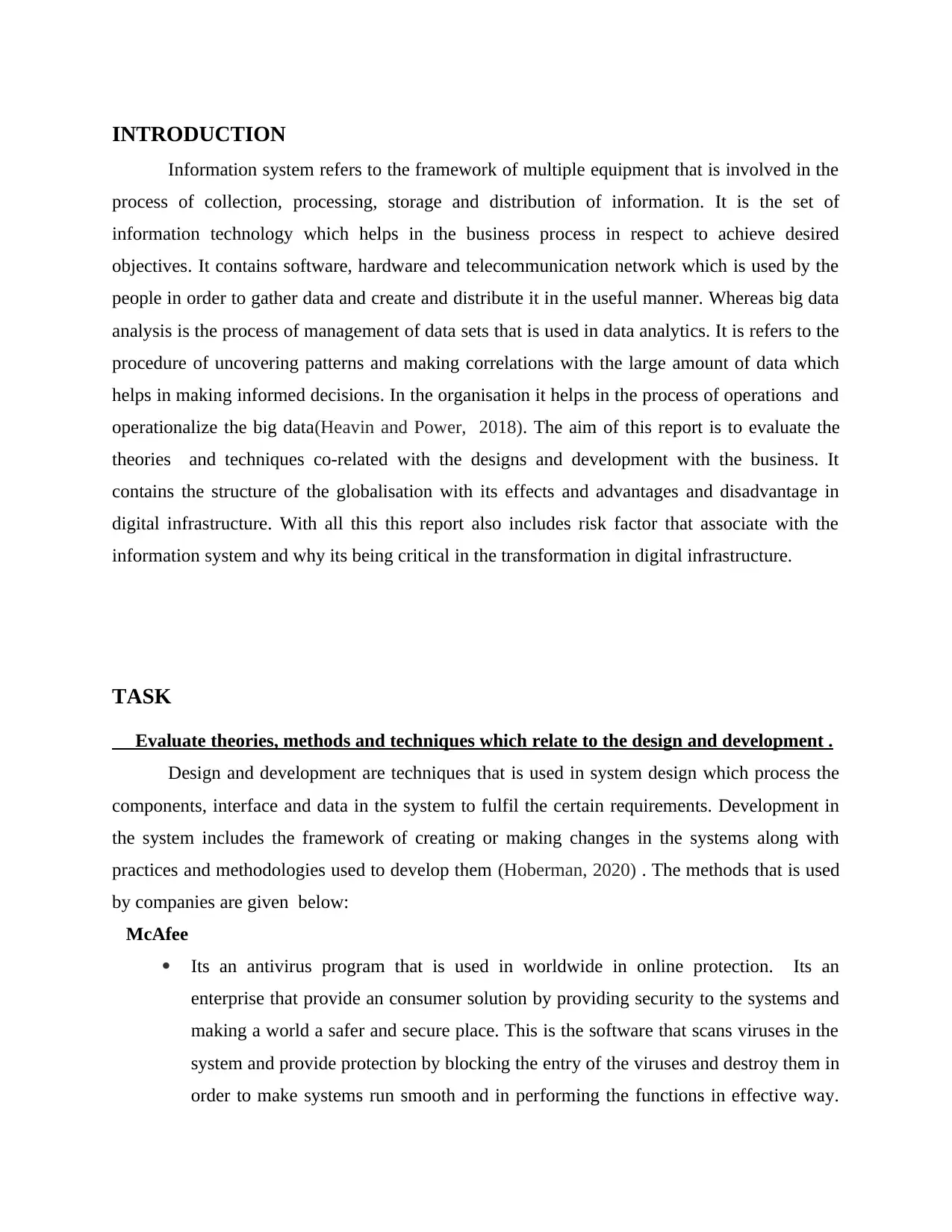
INTRODUCTION
Information system refers to the framework of multiple equipment that is involved in the
process of collection, processing, storage and distribution of information. It is the set of
information technology which helps in the business process in respect to achieve desired
objectives. It contains software, hardware and telecommunication network which is used by the
people in order to gather data and create and distribute it in the useful manner. Whereas big data
analysis is the process of management of data sets that is used in data analytics. It is refers to the
procedure of uncovering patterns and making correlations with the large amount of data which
helps in making informed decisions. In the organisation it helps in the process of operations and
operationalize the big data(Heavin and Power, 2018). The aim of this report is to evaluate the
theories and techniques co-related with the designs and development with the business. It
contains the structure of the globalisation with its effects and advantages and disadvantage in
digital infrastructure. With all this this report also includes risk factor that associate with the
information system and why its being critical in the transformation in digital infrastructure.
TASK
Evaluate theories, methods and techniques which relate to the design and development .
Design and development are techniques that is used in system design which process the
components, interface and data in the system to fulfil the certain requirements. Development in
the system includes the framework of creating or making changes in the systems along with
practices and methodologies used to develop them (Hoberman, 2020) . The methods that is used
by companies are given below:
McAfee
Its an antivirus program that is used in worldwide in online protection. Its an
enterprise that provide an consumer solution by providing security to the systems and
making a world a safer and secure place. This is the software that scans viruses in the
system and provide protection by blocking the entry of the viruses and destroy them in
order to make systems run smooth and in performing the functions in effective way.
Information system refers to the framework of multiple equipment that is involved in the
process of collection, processing, storage and distribution of information. It is the set of
information technology which helps in the business process in respect to achieve desired
objectives. It contains software, hardware and telecommunication network which is used by the
people in order to gather data and create and distribute it in the useful manner. Whereas big data
analysis is the process of management of data sets that is used in data analytics. It is refers to the
procedure of uncovering patterns and making correlations with the large amount of data which
helps in making informed decisions. In the organisation it helps in the process of operations and
operationalize the big data(Heavin and Power, 2018). The aim of this report is to evaluate the
theories and techniques co-related with the designs and development with the business. It
contains the structure of the globalisation with its effects and advantages and disadvantage in
digital infrastructure. With all this this report also includes risk factor that associate with the
information system and why its being critical in the transformation in digital infrastructure.
TASK
Evaluate theories, methods and techniques which relate to the design and development .
Design and development are techniques that is used in system design which process the
components, interface and data in the system to fulfil the certain requirements. Development in
the system includes the framework of creating or making changes in the systems along with
practices and methodologies used to develop them (Hoberman, 2020) . The methods that is used
by companies are given below:
McAfee
Its an antivirus program that is used in worldwide in online protection. Its an
enterprise that provide an consumer solution by providing security to the systems and
making a world a safer and secure place. This is the software that scans viruses in the
system and provide protection by blocking the entry of the viruses and destroy them in
order to make systems run smooth and in performing the functions in effective way.
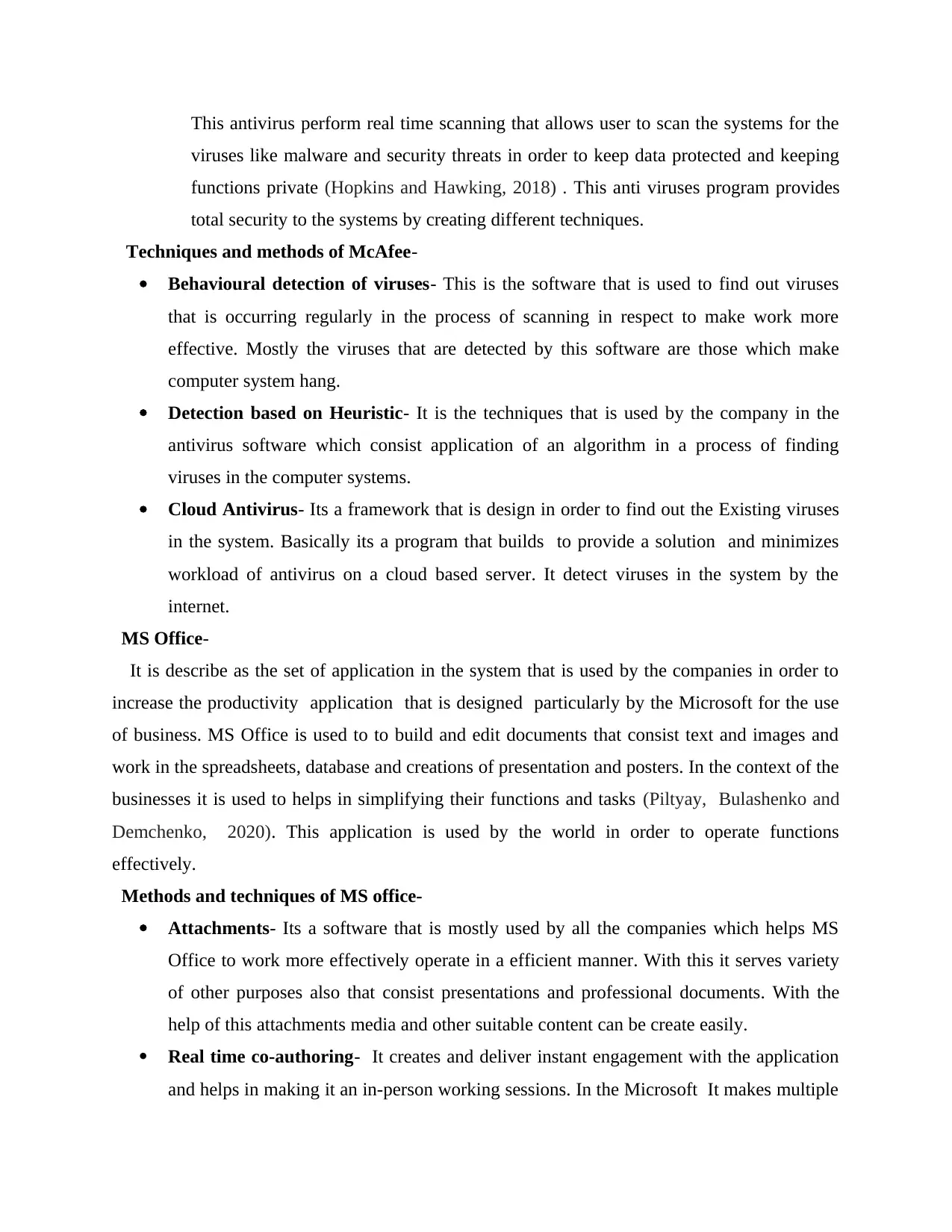
This antivirus perform real time scanning that allows user to scan the systems for the
viruses like malware and security threats in order to keep data protected and keeping
functions private (Hopkins and Hawking, 2018) . This anti viruses program provides
total security to the systems by creating different techniques.
Techniques and methods of McAfee-
Behavioural detection of viruses- This is the software that is used to find out viruses
that is occurring regularly in the process of scanning in respect to make work more
effective. Mostly the viruses that are detected by this software are those which make
computer system hang.
Detection based on Heuristic- It is the techniques that is used by the company in the
antivirus software which consist application of an algorithm in a process of finding
viruses in the computer systems.
Cloud Antivirus- Its a framework that is design in order to find out the Existing viruses
in the system. Basically its a program that builds to provide a solution and minimizes
workload of antivirus on a cloud based server. It detect viruses in the system by the
internet.
MS Office-
It is describe as the set of application in the system that is used by the companies in order to
increase the productivity application that is designed particularly by the Microsoft for the use
of business. MS Office is used to to build and edit documents that consist text and images and
work in the spreadsheets, database and creations of presentation and posters. In the context of the
businesses it is used to helps in simplifying their functions and tasks (Piltyay, Bulashenko and
Demchenko, 2020). This application is used by the world in order to operate functions
effectively.
Methods and techniques of MS office-
Attachments- Its a software that is mostly used by all the companies which helps MS
Office to work more effectively operate in a efficient manner. With this it serves variety
of other purposes also that consist presentations and professional documents. With the
help of this attachments media and other suitable content can be create easily.
Real time co-authoring- It creates and deliver instant engagement with the application
and helps in making it an in-person working sessions. In the Microsoft It makes multiple
viruses like malware and security threats in order to keep data protected and keeping
functions private (Hopkins and Hawking, 2018) . This anti viruses program provides
total security to the systems by creating different techniques.
Techniques and methods of McAfee-
Behavioural detection of viruses- This is the software that is used to find out viruses
that is occurring regularly in the process of scanning in respect to make work more
effective. Mostly the viruses that are detected by this software are those which make
computer system hang.
Detection based on Heuristic- It is the techniques that is used by the company in the
antivirus software which consist application of an algorithm in a process of finding
viruses in the computer systems.
Cloud Antivirus- Its a framework that is design in order to find out the Existing viruses
in the system. Basically its a program that builds to provide a solution and minimizes
workload of antivirus on a cloud based server. It detect viruses in the system by the
internet.
MS Office-
It is describe as the set of application in the system that is used by the companies in order to
increase the productivity application that is designed particularly by the Microsoft for the use
of business. MS Office is used to to build and edit documents that consist text and images and
work in the spreadsheets, database and creations of presentation and posters. In the context of the
businesses it is used to helps in simplifying their functions and tasks (Piltyay, Bulashenko and
Demchenko, 2020). This application is used by the world in order to operate functions
effectively.
Methods and techniques of MS office-
Attachments- Its a software that is mostly used by all the companies which helps MS
Office to work more effectively operate in a efficient manner. With this it serves variety
of other purposes also that consist presentations and professional documents. With the
help of this attachments media and other suitable content can be create easily.
Real time co-authoring- It creates and deliver instant engagement with the application
and helps in making it an in-person working sessions. In the Microsoft It makes multiple
Secure Best Marks with AI Grader
Need help grading? Try our AI Grader for instant feedback on your assignments.
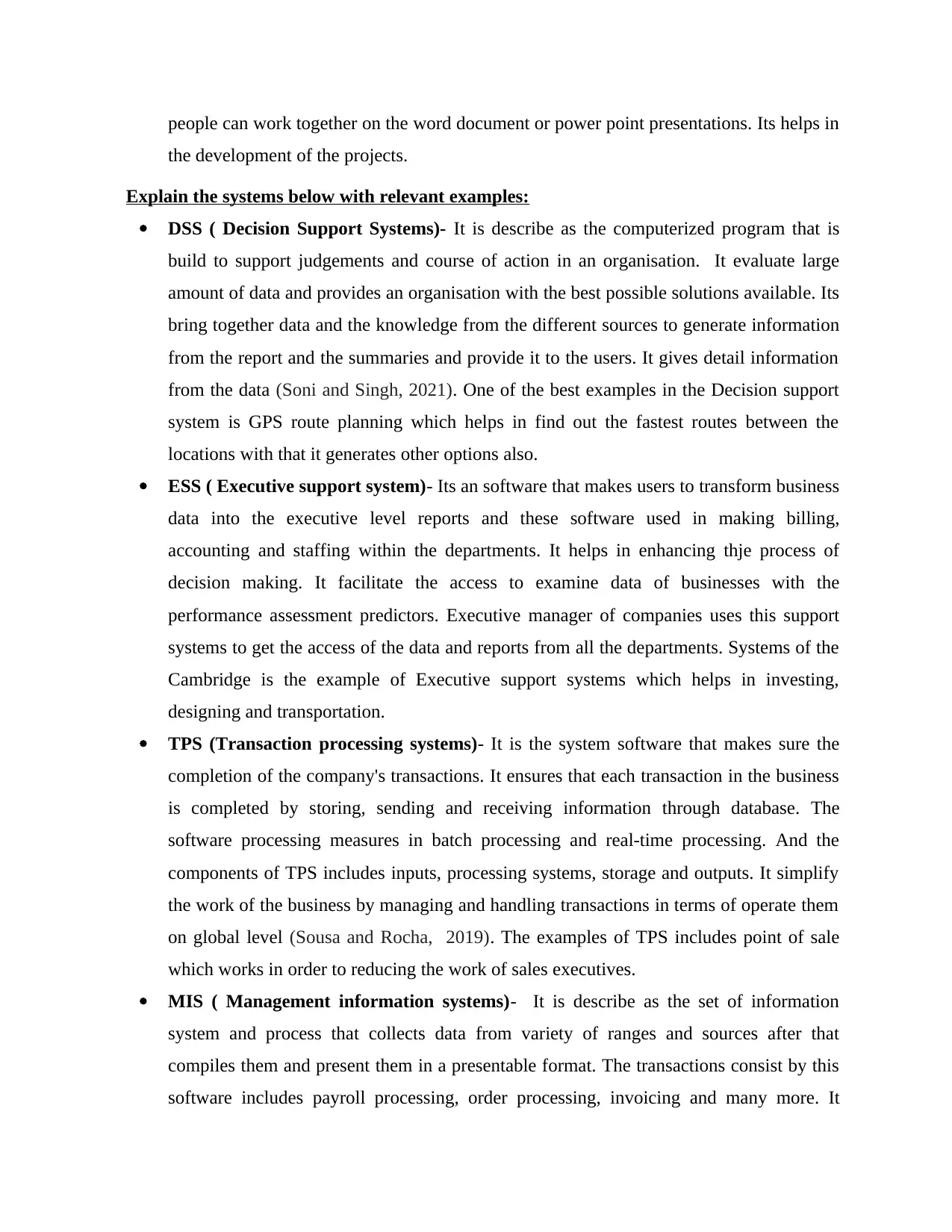
people can work together on the word document or power point presentations. Its helps in
the development of the projects.
Explain the systems below with relevant examples:
DSS ( Decision Support Systems)- It is describe as the computerized program that is
build to support judgements and course of action in an organisation. It evaluate large
amount of data and provides an organisation with the best possible solutions available. Its
bring together data and the knowledge from the different sources to generate information
from the report and the summaries and provide it to the users. It gives detail information
from the data (Soni and Singh, 2021). One of the best examples in the Decision support
system is GPS route planning which helps in find out the fastest routes between the
locations with that it generates other options also.
ESS ( Executive support system)- Its an software that makes users to transform business
data into the executive level reports and these software used in making billing,
accounting and staffing within the departments. It helps in enhancing thje process of
decision making. It facilitate the access to examine data of businesses with the
performance assessment predictors. Executive manager of companies uses this support
systems to get the access of the data and reports from all the departments. Systems of the
Cambridge is the example of Executive support systems which helps in investing,
designing and transportation.
TPS (Transaction processing systems)- It is the system software that makes sure the
completion of the company's transactions. It ensures that each transaction in the business
is completed by storing, sending and receiving information through database. The
software processing measures in batch processing and real-time processing. And the
components of TPS includes inputs, processing systems, storage and outputs. It simplify
the work of the business by managing and handling transactions in terms of operate them
on global level (Sousa and Rocha, 2019). The examples of TPS includes point of sale
which works in order to reducing the work of sales executives.
MIS ( Management information systems)- It is describe as the set of information
system and process that collects data from variety of ranges and sources after that
compiles them and present them in a presentable format. The transactions consist by this
software includes payroll processing, order processing, invoicing and many more. It
the development of the projects.
Explain the systems below with relevant examples:
DSS ( Decision Support Systems)- It is describe as the computerized program that is
build to support judgements and course of action in an organisation. It evaluate large
amount of data and provides an organisation with the best possible solutions available. Its
bring together data and the knowledge from the different sources to generate information
from the report and the summaries and provide it to the users. It gives detail information
from the data (Soni and Singh, 2021). One of the best examples in the Decision support
system is GPS route planning which helps in find out the fastest routes between the
locations with that it generates other options also.
ESS ( Executive support system)- Its an software that makes users to transform business
data into the executive level reports and these software used in making billing,
accounting and staffing within the departments. It helps in enhancing thje process of
decision making. It facilitate the access to examine data of businesses with the
performance assessment predictors. Executive manager of companies uses this support
systems to get the access of the data and reports from all the departments. Systems of the
Cambridge is the example of Executive support systems which helps in investing,
designing and transportation.
TPS (Transaction processing systems)- It is the system software that makes sure the
completion of the company's transactions. It ensures that each transaction in the business
is completed by storing, sending and receiving information through database. The
software processing measures in batch processing and real-time processing. And the
components of TPS includes inputs, processing systems, storage and outputs. It simplify
the work of the business by managing and handling transactions in terms of operate them
on global level (Sousa and Rocha, 2019). The examples of TPS includes point of sale
which works in order to reducing the work of sales executives.
MIS ( Management information systems)- It is describe as the set of information
system and process that collects data from variety of ranges and sources after that
compiles them and present them in a presentable format. The transactions consist by this
software includes payroll processing, order processing, invoicing and many more. It
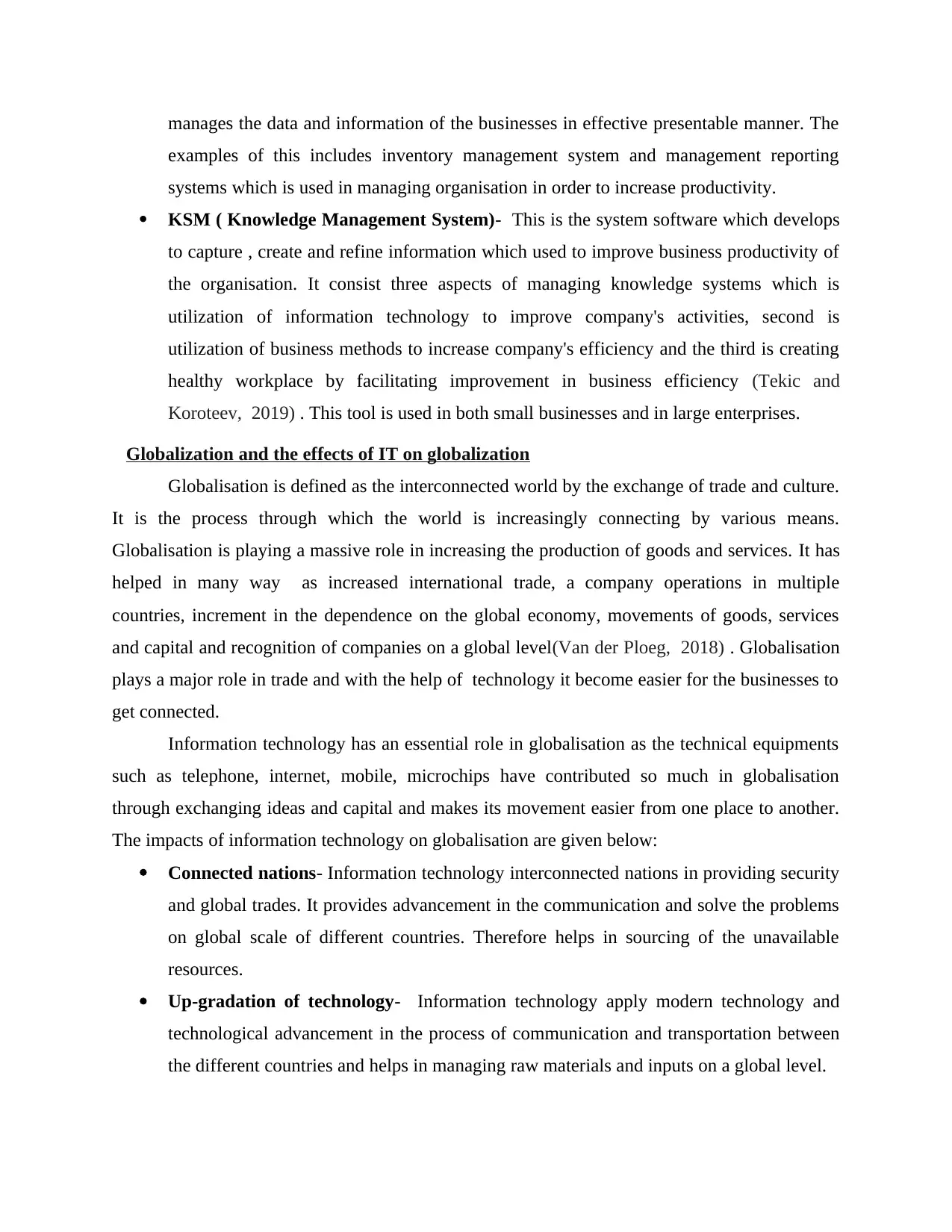
manages the data and information of the businesses in effective presentable manner. The
examples of this includes inventory management system and management reporting
systems which is used in managing organisation in order to increase productivity.
KSM ( Knowledge Management System)- This is the system software which develops
to capture , create and refine information which used to improve business productivity of
the organisation. It consist three aspects of managing knowledge systems which is
utilization of information technology to improve company's activities, second is
utilization of business methods to increase company's efficiency and the third is creating
healthy workplace by facilitating improvement in business efficiency (Tekic and
Koroteev, 2019) . This tool is used in both small businesses and in large enterprises.
Globalization and the effects of IT on globalization
Globalisation is defined as the interconnected world by the exchange of trade and culture.
It is the process through which the world is increasingly connecting by various means.
Globalisation is playing a massive role in increasing the production of goods and services. It has
helped in many way as increased international trade, a company operations in multiple
countries, increment in the dependence on the global economy, movements of goods, services
and capital and recognition of companies on a global level(Van der Ploeg, 2018) . Globalisation
plays a major role in trade and with the help of technology it become easier for the businesses to
get connected.
Information technology has an essential role in globalisation as the technical equipments
such as telephone, internet, mobile, microchips have contributed so much in globalisation
through exchanging ideas and capital and makes its movement easier from one place to another.
The impacts of information technology on globalisation are given below:
Connected nations- Information technology interconnected nations in providing security
and global trades. It provides advancement in the communication and solve the problems
on global scale of different countries. Therefore helps in sourcing of the unavailable
resources.
Up-gradation of technology- Information technology apply modern technology and
technological advancement in the process of communication and transportation between
the different countries and helps in managing raw materials and inputs on a global level.
examples of this includes inventory management system and management reporting
systems which is used in managing organisation in order to increase productivity.
KSM ( Knowledge Management System)- This is the system software which develops
to capture , create and refine information which used to improve business productivity of
the organisation. It consist three aspects of managing knowledge systems which is
utilization of information technology to improve company's activities, second is
utilization of business methods to increase company's efficiency and the third is creating
healthy workplace by facilitating improvement in business efficiency (Tekic and
Koroteev, 2019) . This tool is used in both small businesses and in large enterprises.
Globalization and the effects of IT on globalization
Globalisation is defined as the interconnected world by the exchange of trade and culture.
It is the process through which the world is increasingly connecting by various means.
Globalisation is playing a massive role in increasing the production of goods and services. It has
helped in many way as increased international trade, a company operations in multiple
countries, increment in the dependence on the global economy, movements of goods, services
and capital and recognition of companies on a global level(Van der Ploeg, 2018) . Globalisation
plays a major role in trade and with the help of technology it become easier for the businesses to
get connected.
Information technology has an essential role in globalisation as the technical equipments
such as telephone, internet, mobile, microchips have contributed so much in globalisation
through exchanging ideas and capital and makes its movement easier from one place to another.
The impacts of information technology on globalisation are given below:
Connected nations- Information technology interconnected nations in providing security
and global trades. It provides advancement in the communication and solve the problems
on global scale of different countries. Therefore helps in sourcing of the unavailable
resources.
Up-gradation of technology- Information technology apply modern technology and
technological advancement in the process of communication and transportation between
the different countries and helps in managing raw materials and inputs on a global level.
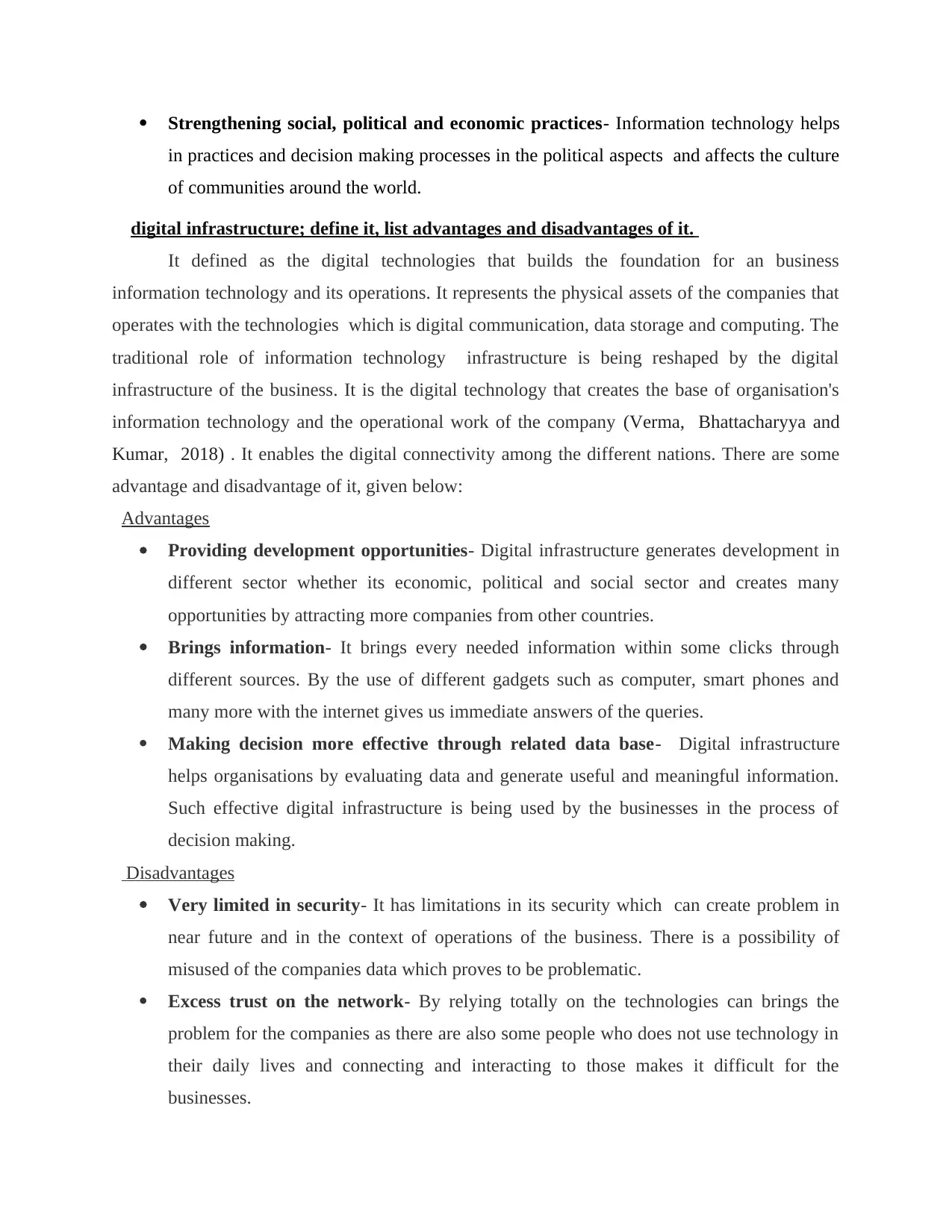
Strengthening social, political and economic practices- Information technology helps
in practices and decision making processes in the political aspects and affects the culture
of communities around the world.
digital infrastructure; define it, list advantages and disadvantages of it.
It defined as the digital technologies that builds the foundation for an business
information technology and its operations. It represents the physical assets of the companies that
operates with the technologies which is digital communication, data storage and computing. The
traditional role of information technology infrastructure is being reshaped by the digital
infrastructure of the business. It is the digital technology that creates the base of organisation's
information technology and the operational work of the company (Verma, Bhattacharyya and
Kumar, 2018) . It enables the digital connectivity among the different nations. There are some
advantage and disadvantage of it, given below:
Advantages
Providing development opportunities- Digital infrastructure generates development in
different sector whether its economic, political and social sector and creates many
opportunities by attracting more companies from other countries.
Brings information- It brings every needed information within some clicks through
different sources. By the use of different gadgets such as computer, smart phones and
many more with the internet gives us immediate answers of the queries.
Making decision more effective through related data base- Digital infrastructure
helps organisations by evaluating data and generate useful and meaningful information.
Such effective digital infrastructure is being used by the businesses in the process of
decision making.
Disadvantages
Very limited in security- It has limitations in its security which can create problem in
near future and in the context of operations of the business. There is a possibility of
misused of the companies data which proves to be problematic.
Excess trust on the network- By relying totally on the technologies can brings the
problem for the companies as there are also some people who does not use technology in
their daily lives and connecting and interacting to those makes it difficult for the
businesses.
in practices and decision making processes in the political aspects and affects the culture
of communities around the world.
digital infrastructure; define it, list advantages and disadvantages of it.
It defined as the digital technologies that builds the foundation for an business
information technology and its operations. It represents the physical assets of the companies that
operates with the technologies which is digital communication, data storage and computing. The
traditional role of information technology infrastructure is being reshaped by the digital
infrastructure of the business. It is the digital technology that creates the base of organisation's
information technology and the operational work of the company (Verma, Bhattacharyya and
Kumar, 2018) . It enables the digital connectivity among the different nations. There are some
advantage and disadvantage of it, given below:
Advantages
Providing development opportunities- Digital infrastructure generates development in
different sector whether its economic, political and social sector and creates many
opportunities by attracting more companies from other countries.
Brings information- It brings every needed information within some clicks through
different sources. By the use of different gadgets such as computer, smart phones and
many more with the internet gives us immediate answers of the queries.
Making decision more effective through related data base- Digital infrastructure
helps organisations by evaluating data and generate useful and meaningful information.
Such effective digital infrastructure is being used by the businesses in the process of
decision making.
Disadvantages
Very limited in security- It has limitations in its security which can create problem in
near future and in the context of operations of the business. There is a possibility of
misused of the companies data which proves to be problematic.
Excess trust on the network- By relying totally on the technologies can brings the
problem for the companies as there are also some people who does not use technology in
their daily lives and connecting and interacting to those makes it difficult for the
businesses.
Paraphrase This Document
Need a fresh take? Get an instant paraphrase of this document with our AI Paraphraser
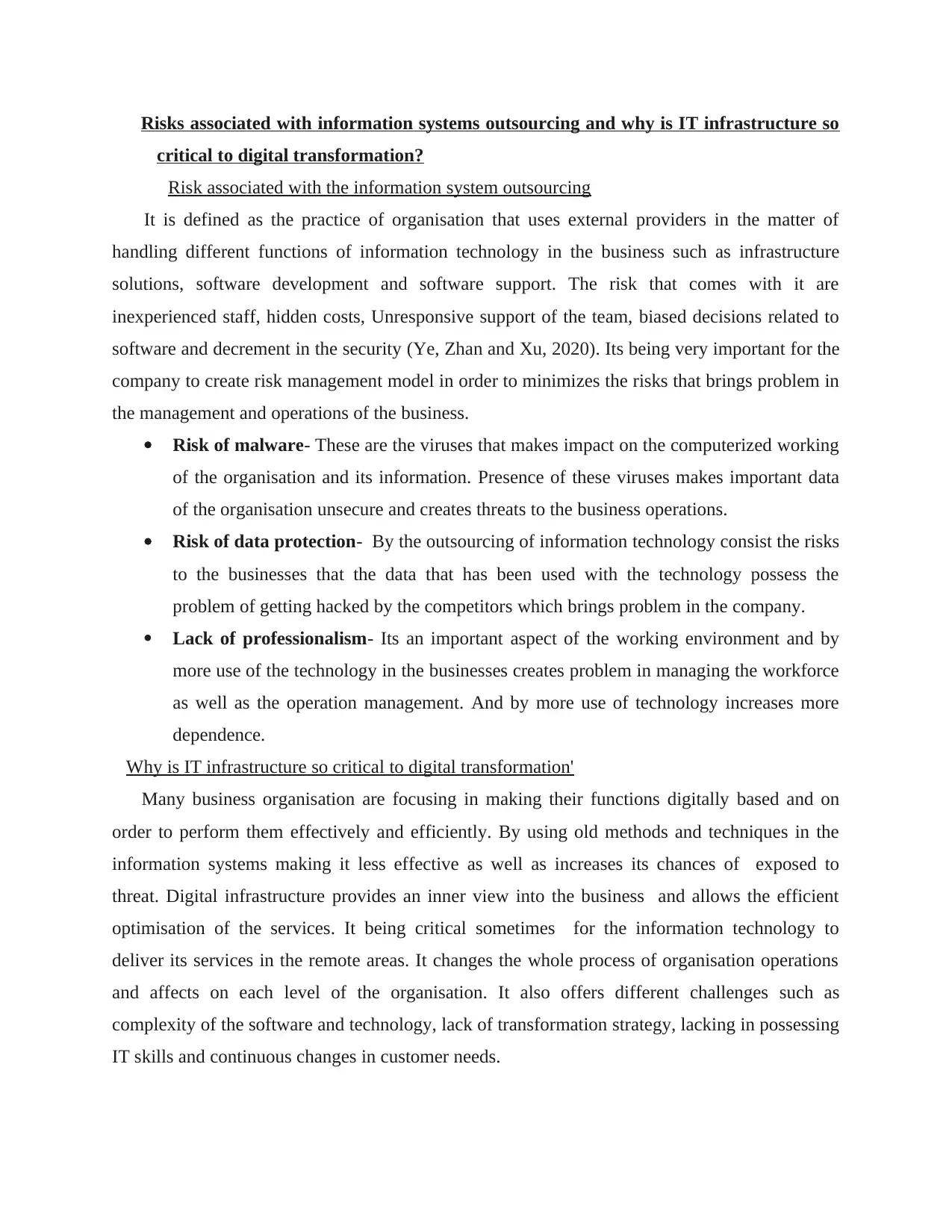
Risks associated with information systems outsourcing and why is IT infrastructure so
critical to digital transformation?
Risk associated with the information system outsourcing
It is defined as the practice of organisation that uses external providers in the matter of
handling different functions of information technology in the business such as infrastructure
solutions, software development and software support. The risk that comes with it are
inexperienced staff, hidden costs, Unresponsive support of the team, biased decisions related to
software and decrement in the security (Ye, Zhan and Xu, 2020). Its being very important for the
company to create risk management model in order to minimizes the risks that brings problem in
the management and operations of the business.
Risk of malware- These are the viruses that makes impact on the computerized working
of the organisation and its information. Presence of these viruses makes important data
of the organisation unsecure and creates threats to the business operations.
Risk of data protection- By the outsourcing of information technology consist the risks
to the businesses that the data that has been used with the technology possess the
problem of getting hacked by the competitors which brings problem in the company.
Lack of professionalism- Its an important aspect of the working environment and by
more use of the technology in the businesses creates problem in managing the workforce
as well as the operation management. And by more use of technology increases more
dependence.
Why is IT infrastructure so critical to digital transformation'
Many business organisation are focusing in making their functions digitally based and on
order to perform them effectively and efficiently. By using old methods and techniques in the
information systems making it less effective as well as increases its chances of exposed to
threat. Digital infrastructure provides an inner view into the business and allows the efficient
optimisation of the services. It being critical sometimes for the information technology to
deliver its services in the remote areas. It changes the whole process of organisation operations
and affects on each level of the organisation. It also offers different challenges such as
complexity of the software and technology, lack of transformation strategy, lacking in possessing
IT skills and continuous changes in customer needs.
critical to digital transformation?
Risk associated with the information system outsourcing
It is defined as the practice of organisation that uses external providers in the matter of
handling different functions of information technology in the business such as infrastructure
solutions, software development and software support. The risk that comes with it are
inexperienced staff, hidden costs, Unresponsive support of the team, biased decisions related to
software and decrement in the security (Ye, Zhan and Xu, 2020). Its being very important for the
company to create risk management model in order to minimizes the risks that brings problem in
the management and operations of the business.
Risk of malware- These are the viruses that makes impact on the computerized working
of the organisation and its information. Presence of these viruses makes important data
of the organisation unsecure and creates threats to the business operations.
Risk of data protection- By the outsourcing of information technology consist the risks
to the businesses that the data that has been used with the technology possess the
problem of getting hacked by the competitors which brings problem in the company.
Lack of professionalism- Its an important aspect of the working environment and by
more use of the technology in the businesses creates problem in managing the workforce
as well as the operation management. And by more use of technology increases more
dependence.
Why is IT infrastructure so critical to digital transformation'
Many business organisation are focusing in making their functions digitally based and on
order to perform them effectively and efficiently. By using old methods and techniques in the
information systems making it less effective as well as increases its chances of exposed to
threat. Digital infrastructure provides an inner view into the business and allows the efficient
optimisation of the services. It being critical sometimes for the information technology to
deliver its services in the remote areas. It changes the whole process of organisation operations
and affects on each level of the organisation. It also offers different challenges such as
complexity of the software and technology, lack of transformation strategy, lacking in possessing
IT skills and continuous changes in customer needs.
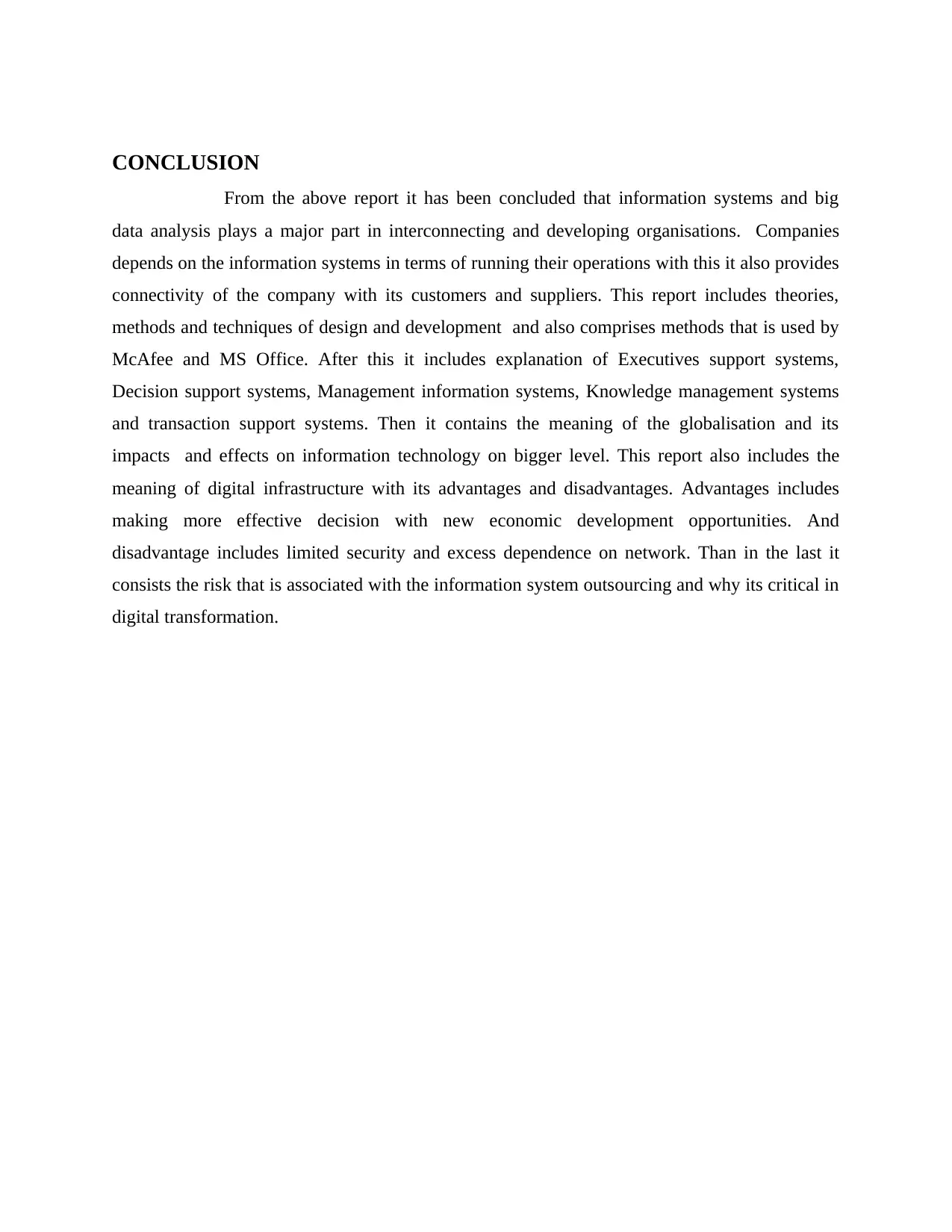
CONCLUSION
From the above report it has been concluded that information systems and big
data analysis plays a major part in interconnecting and developing organisations. Companies
depends on the information systems in terms of running their operations with this it also provides
connectivity of the company with its customers and suppliers. This report includes theories,
methods and techniques of design and development and also comprises methods that is used by
McAfee and MS Office. After this it includes explanation of Executives support systems,
Decision support systems, Management information systems, Knowledge management systems
and transaction support systems. Then it contains the meaning of the globalisation and its
impacts and effects on information technology on bigger level. This report also includes the
meaning of digital infrastructure with its advantages and disadvantages. Advantages includes
making more effective decision with new economic development opportunities. And
disadvantage includes limited security and excess dependence on network. Than in the last it
consists the risk that is associated with the information system outsourcing and why its critical in
digital transformation.
From the above report it has been concluded that information systems and big
data analysis plays a major part in interconnecting and developing organisations. Companies
depends on the information systems in terms of running their operations with this it also provides
connectivity of the company with its customers and suppliers. This report includes theories,
methods and techniques of design and development and also comprises methods that is used by
McAfee and MS Office. After this it includes explanation of Executives support systems,
Decision support systems, Management information systems, Knowledge management systems
and transaction support systems. Then it contains the meaning of the globalisation and its
impacts and effects on information technology on bigger level. This report also includes the
meaning of digital infrastructure with its advantages and disadvantages. Advantages includes
making more effective decision with new economic development opportunities. And
disadvantage includes limited security and excess dependence on network. Than in the last it
consists the risk that is associated with the information system outsourcing and why its critical in
digital transformation.
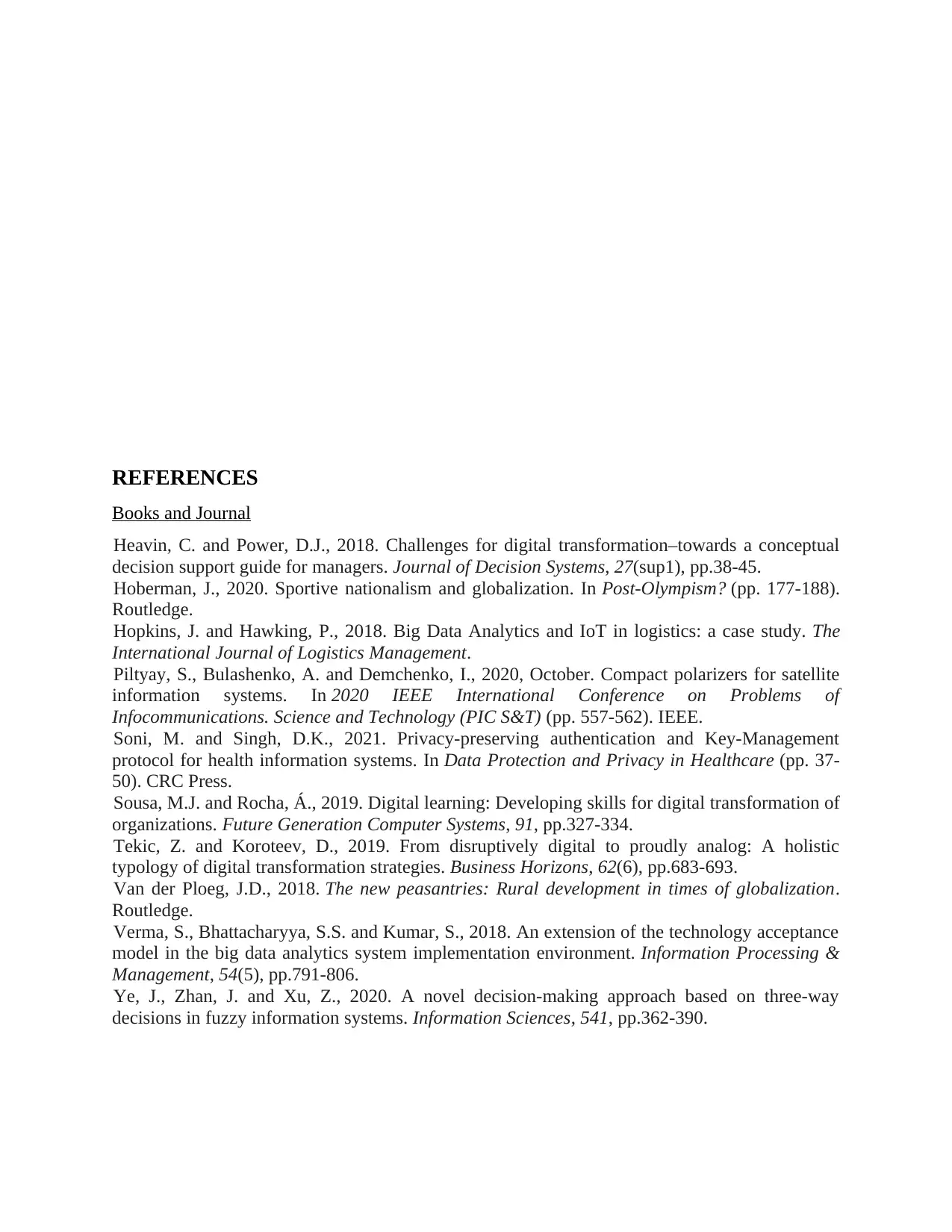
REFERENCES
Books and Journal
Heavin, C. and Power, D.J., 2018. Challenges for digital transformation–towards a conceptual
decision support guide for managers. Journal of Decision Systems, 27(sup1), pp.38-45.
Hoberman, J., 2020. Sportive nationalism and globalization. In Post-Olympism? (pp. 177-188).
Routledge.
Hopkins, J. and Hawking, P., 2018. Big Data Analytics and IoT in logistics: a case study. The
International Journal of Logistics Management.
Piltyay, S., Bulashenko, A. and Demchenko, I., 2020, October. Compact polarizers for satellite
information systems. In 2020 IEEE International Conference on Problems of
Infocommunications. Science and Technology (PIC S&T) (pp. 557-562). IEEE.
Soni, M. and Singh, D.K., 2021. Privacy-preserving authentication and Key-Management
protocol for health information systems. In Data Protection and Privacy in Healthcare (pp. 37-
50). CRC Press.
Sousa, M.J. and Rocha, Á., 2019. Digital learning: Developing skills for digital transformation of
organizations. Future Generation Computer Systems, 91, pp.327-334.
Tekic, Z. and Koroteev, D., 2019. From disruptively digital to proudly analog: A holistic
typology of digital transformation strategies. Business Horizons, 62(6), pp.683-693.
Van der Ploeg, J.D., 2018. The new peasantries: Rural development in times of globalization.
Routledge.
Verma, S., Bhattacharyya, S.S. and Kumar, S., 2018. An extension of the technology acceptance
model in the big data analytics system implementation environment. Information Processing &
Management, 54(5), pp.791-806.
Ye, J., Zhan, J. and Xu, Z., 2020. A novel decision-making approach based on three-way
decisions in fuzzy information systems. Information Sciences, 541, pp.362-390.
Books and Journal
Heavin, C. and Power, D.J., 2018. Challenges for digital transformation–towards a conceptual
decision support guide for managers. Journal of Decision Systems, 27(sup1), pp.38-45.
Hoberman, J., 2020. Sportive nationalism and globalization. In Post-Olympism? (pp. 177-188).
Routledge.
Hopkins, J. and Hawking, P., 2018. Big Data Analytics and IoT in logistics: a case study. The
International Journal of Logistics Management.
Piltyay, S., Bulashenko, A. and Demchenko, I., 2020, October. Compact polarizers for satellite
information systems. In 2020 IEEE International Conference on Problems of
Infocommunications. Science and Technology (PIC S&T) (pp. 557-562). IEEE.
Soni, M. and Singh, D.K., 2021. Privacy-preserving authentication and Key-Management
protocol for health information systems. In Data Protection and Privacy in Healthcare (pp. 37-
50). CRC Press.
Sousa, M.J. and Rocha, Á., 2019. Digital learning: Developing skills for digital transformation of
organizations. Future Generation Computer Systems, 91, pp.327-334.
Tekic, Z. and Koroteev, D., 2019. From disruptively digital to proudly analog: A holistic
typology of digital transformation strategies. Business Horizons, 62(6), pp.683-693.
Van der Ploeg, J.D., 2018. The new peasantries: Rural development in times of globalization.
Routledge.
Verma, S., Bhattacharyya, S.S. and Kumar, S., 2018. An extension of the technology acceptance
model in the big data analytics system implementation environment. Information Processing &
Management, 54(5), pp.791-806.
Ye, J., Zhan, J. and Xu, Z., 2020. A novel decision-making approach based on three-way
decisions in fuzzy information systems. Information Sciences, 541, pp.362-390.
1 out of 10
Related Documents
Your All-in-One AI-Powered Toolkit for Academic Success.
+13062052269
info@desklib.com
Available 24*7 on WhatsApp / Email
![[object Object]](/_next/static/media/star-bottom.7253800d.svg)
Unlock your academic potential
© 2024 | Zucol Services PVT LTD | All rights reserved.





